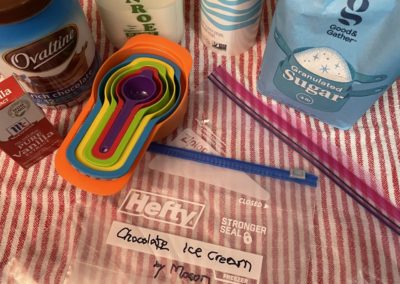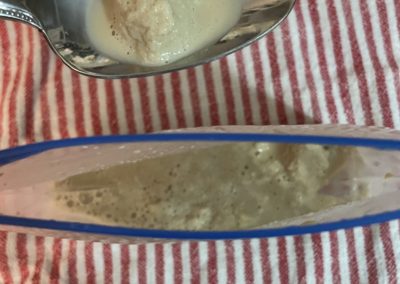Ice Cream in a Bag
Developed by Julie Klann, PCM Play Intensive 2021
(FOCUS: Grade 1-5, STEAM, Science, Literacy, Creativity & Learning, Engineering/Scientific Method)
In this lesson, students will act as scientists and develop their understanding about the properties of matter, especially two elements of matter- solid and liquids. They will develop their understanding of the scientific process, plan and lastly experiment in changing matter from its liquid form to a solid form by changing the temperature. They will realize that energy can cause matter to change, and that matter is all around us.
Students will follow the science practices of observation, constructing explanations, using evidence to support a claim, and designing an experiment. They will practice following directions and measuring with accuracy.
Materials
- 1 cup Half & Half
- 2 tbsp of Sugar
- 1/2 tsp Vanilla Extract
- 3 cups of Ice
- 1/3 cup rock salt
- sandwich size zipper closing bag
- gallon size zipper closing bag
- Plastic Spoon
- recording sheet to for observations
- paper towels, towel, napkins
- Ice cream in a bag recipe
Optional: *You can choose to add 1 tbl of chocolate syrup to your bag*
Set Up
Gather all materials and place in front of you before beginning. Place enough Ice (about 3 cups) Into a large (1 gallon) Ziploc bag (ice should cover about ½ of the bag). Place a towel or sheet down in case spilling occurs.
Student’s Job
Can you investigate how a liquid mixture changes when it is cooled and heated?
Can you take ice, mix it with salt and make delicious, edible, ice cream?
Prep:
- Gather your materials you will need for the investigation and make sure they are in front of you, except the ice. Grab your ice right before you begin. (Think: You’ll want everything easily accessible when completing your investigation.)
- Place a towel or layer down to prevent spills or messes.
- Review the recipe card and keep with you during the experiment to make sure you are able to successfully complete independently and accurately.
Mixing Time:
- Take the gallon zipper closing bag and fill it with ½ full of ice, then add 1/3 cup of rock salt to it.
- In the smaller zipper closing bag, place 1 cup of half and half, 2 tbsp of sugar, ½ tsp of Vanilla and seal the bag to ensure no liquid escapes. * If you choose to add chocolate, add the syrup with the mixture before sealing*
- Double check to make sure the bag has a tight seal.
- Place the smaller Ziploc bag in the gallon size Ziploc bag with the ice and salt.
- Squeeze the air out of the bag and seal tightly.
- Again double check to make sure the bag has a tight seal.
- Shake the bag vigorously for 5-10 minutes making sure the ice is surrounding the cream mixture during. *You may want to ask for assistance with the shaking!*
Eating Time:
- Open the large Ziploc and take out the smaller Ziploc bag to find your liquid mixture is now ICE CREAM!
- Place the small Ziploc on the towel or layer provided and wipe off any excess ice/salt mixture.
- Open your bag of ice cream carefully and ENJOY!
*Remember- scientists are constantly reviewing, revising, and retrying experiments. If it does not come out as expected the 1st time, TRY again*
Further Challenges:
- Journal Writing:
- Compare and contrast the characteristics of Liquid & Solid Matter
- Observing & drawing changes as the liquid changed
- Melt an Ice Cube (find the fastest way to melt an ice cube)
- Butter Making
- Fireworks in a glass
- How To Writing: How to make Ice Cream in a Bag
- Evaporating water experiment
Teacher’s Job
Standards Alignment
COMMON CORE STATE STANDARDS.MATH.CONTENT.3.MEASUREMENT & DATA.A.2
Measure and estimate liquid volumes and masses of objects using standard units of grams (g), kilograms (kg), and liters (l).
COMMON CORE STATE STANDARDS.ELA-LITERACY.SPEAKING & LISTENING.2.1.A
Follow agreed-upon rules for discussions (e.g., gaining the floor in respectful ways, listening to others with care, speaking one at a time about the topics and texts under discussion).
NEXT GENERATION SCIENCE STANDARDS: MATTER & ITS INTERACTIONS
2- PS1-1: Plan and conduct an investigation to describe and classify different kinds of materials by their observable properties.
NEXT GENERATION SCIENCE STANDARDS: ENGINEERING, TECHNOLOGY, AND APPLICATIONS OF SCIENCE
K-2-ETS1-1: Ask questions, make observations, and gather information about a situation people want to change to define a simple problem that can be solved through the development of a new or improved object or tool.
K-2-ETS1-2: Develop a simple sketch, drawing, or physical model to illustrate how the shape of an object helps it function as needed to solve a given problem.
K-2-ETS1-3: Analyze data from tests of two objects designed to solve the same problem to compare the strengths and weaknesses of how each performs.
Connections to previous work?
Solids & Liquids Foss Web. In the grade 2 Solids & Liquids module, students learn about matter in it’s 3 phases and its characteristics. Students observe, describe, and compare properties of solids and liquids. They gain firsthand experience with reversible changes caused by heating or cooling, and read about changes caused by heating that are irreversible.
Prepare/ Background Info
- Introduction/review of 3 states of Matter: Solids, Liquids and Gases.
- Know how to describe the properties of solids, liquids and gases.
- Know how different kinds of energy can cause matter to change states (solid to liquid, liquid to gas, liquid to solid)
- Scientific Method/Process
Play to Notice
Social, Emotional, Active, Choice, Social Support, Child Centered
Content Matter to Notice
Math, Science



0 Comments